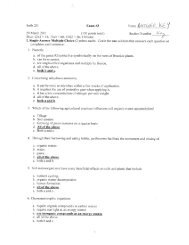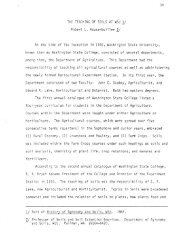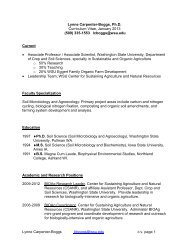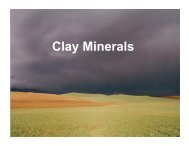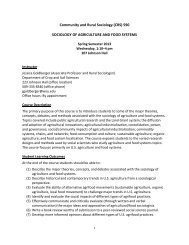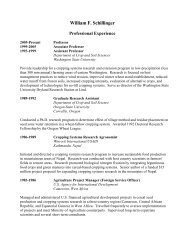2012 Dryland Field Day Abstracts - Dept. of Crop and Soil Sciences ...
2012 Dryland Field Day Abstracts - Dept. of Crop and Soil Sciences ...
2012 Dryland Field Day Abstracts - Dept. of Crop and Soil Sciences ...
Create successful ePaper yourself
Turn your PDF publications into a flip-book with our unique Google optimized e-Paper software.
Page 44<br />
<strong>2012</strong> <strong>Field</strong> <strong>Day</strong> <strong>Abstracts</strong>: Highlights <strong>of</strong> Research Progress<br />
<strong>and</strong> winter wheat (WW) in 2006-07. Regardless <strong>of</strong> the rotation system produced during the transition phase, soil inorganic N levels<br />
were similar among all systems (102 lbs acre -1 ) at the start <strong>of</strong> organic production. However, SW had higher grain yields (3427 lbs<br />
acre -1 ) following intensive FOR or GRM than systems that contained small grains for at least one year during the transition (2514 lbs<br />
acre -1 ). Although organic soil properties improved following legumes compared to small grains, mid-season mowing <strong>of</strong> GRM <strong>and</strong><br />
FOR reduced weed pressure throughout the transition <strong>and</strong> resulted in higher SW yields during certified organic production.<br />
Effective weed control strategies <strong>and</strong> management proved to be as important as increasing soil N for successful organic wheat<br />
production. Winter wheat was more competitive with weeds than SW. Higher WW yields (3748 lbs acre -1 ) were found following<br />
systems that included legumes for at least one year <strong>of</strong> the transition compared to cereal or grain intensive systems (3006 lbs<br />
acre -1 ). Spring <strong>and</strong> WW protein levels were higher when legumes were included for at least one year during the transition. <strong>Soil</strong><br />
inorganic N levels (60 lbs acre -1 ) were low across all systems following two years <strong>of</strong> organic wheat production <strong>and</strong> supplementing<br />
soil N throughout organic production is recommended. Additionally, further research should identify crop types <strong>and</strong> cultivars that<br />
are competitive in low-input, organic production systems.<br />
Management <strong>of</strong> Wheat Density to Optimize Nitrogen <strong>and</strong> Water Use: Implications for Precision<br />
Agriculture<br />
Tabitha T. Brown 1 , David R. Huggins 1,4 , Jeff L. Smith 1,4 , <strong>and</strong> Chad Kruger 2<br />
1 <strong>Dept</strong>. <strong>Crop</strong> <strong>and</strong> <strong>Soil</strong> <strong>Sciences</strong>, WSU; 2 Center for Sustaining Agriculture <strong>and</strong> Natural Resources, WSU, Wenatchee; 3 USDA-ARS,<br />
L<strong>and</strong> Management <strong>and</strong> Water Conservation Unit<br />
In the Palouse region <strong>of</strong> the Pacific Northwest, USA, relationships between productivity, N dynamics <strong>and</strong> cycling, water availability,<br />
<strong>and</strong> environmental impacts result from intricate spatial <strong>and</strong> temporal variability. This complicates application <strong>of</strong> precision<br />
agriculture principles to improve crop <strong>and</strong> soil management. This research aims to investigate site-specific factors regulating<br />
nitrogen use efficiency (NUE) <strong>and</strong> the fate <strong>of</strong> N throughout the<br />
growing season <strong>of</strong> winter wheat (Triticum aestivum L.). Nitrogen<br />
<strong>and</strong> plant density field trials with winter wheat are underway at<br />
the Washington State University Cook Agronomy Farm near<br />
Pullman, WA under long-term no-tillage soil management. A key<br />
objectives <strong>of</strong> this research is to evaluate yield-water availability-<br />
NUE relationships among three l<strong>and</strong>scape positions differing in<br />
yield potential <strong>and</strong> soil properties to improve overall N<br />
management. Preliminary data show that plant density<br />
manipulation combined with precision N applications resulted in<br />
greater wheat yield with less seed <strong>and</strong> N inputs. These findings<br />
indicate that improvements to NUE <strong>and</strong> sustainability <strong>of</strong> Pacific<br />
Northwest dryl<strong>and</strong> agriculture should consider l<strong>and</strong>scape-scale<br />
patterns driving productivity.<br />
Tillage Strategies to Control Blowing Dust <strong>and</strong> PM10 Emissions from Williston Reservoir Beaches in<br />
British Columbia<br />
W. F. Schillinger 1 , P. Shannon 1 , D.W. Fryrear 2 , <strong>and</strong> W.G. Nickling 3;<br />
1 <strong>Dept</strong>. <strong>of</strong> <strong>Crop</strong> <strong>and</strong> <strong>Soil</strong> <strong>Sciences</strong>, WSU; 2 Custom Products, Big Spring, TX 3 <strong>Dept</strong>. <strong>of</strong> Geography, Univ. <strong>of</strong> Guelph, Guelph,<br />
Ontario<br />
Williston Reservoir in northern British Columbia was created when BC Hydro constructed Bennett Dam on the Peace River in 1968<br />
to generate hydroelectric power. Williston Reservoir is the largest body <strong>of</strong> freshwater in British Columbia with a surface area <strong>of</strong> 685<br />
square miles <strong>and</strong> a shoreline <strong>of</strong> 1100 miles. The First Nation Tsay Keh b<strong>and</strong> was forced to relocate to the north end <strong>of</strong> the reservoir<br />
as a result <strong>of</strong> the water impoundment. When reservoir levels are at low pool in the spring, 25,000 acres <strong>of</strong> beach is exposed.<br />
Beaches are exposed for only two months during May <strong>and</strong> June <strong>and</strong> are covered with water during the remainder <strong>of</strong> the year. High




